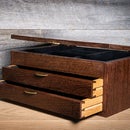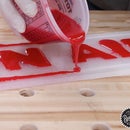Introduction: 5 Minute Hand Plane Sharpening | Woodworking Tool Tip
Learn to sharpen & upkeep your hand planes in less than 5 minutes
For years I was one of those guys who wanted to have the "razor sharp" tools that made woodworking look so soothing and fun. Ironically, i struggled to find the right process for my hand plane sharpening. I didn't want to invest in expensive Jigs and stones, but what i realized was this is a lifelong investment.
So after about 3 years of not much hand tool work, I caught a bug and spent a few hundred bucks on some sharpening tools, and it changed everything when it came to hand plane sharpening and chisel sharpening.
Check out the list of tools I use for sharpening here.
- Veritas Deluxe Honing Jig (or Woodriver Honing Jig)
- Duosharp 8" Diamond stone
- HoneRite Honing Solution
- Shapton Glass Stone - 16,000 Grit
- Honing Compound Leather Strop
In this video I take my brand new Woodriver Low Angle Block Plane and #4 Hand Plane, and take them through my hand plane sharpening process to be ready for some beautiful shavings. Check it out.
Step 1: Flatten Our Glass (or Water) Stone
In this step it is crucial to have a perfectly flat stone. This is for any stone you're using. You want to flatten your stones with a diamond stone, these diamond stones do not wear out. So they're great for creating perfectly flat reference surfaces. You want to use a lubricant for this step to keep the cutting surface on the diamond stone performing optimally. I like to use HoneRite water additive to keep my planes and diamond stones from rusting. You can use just water if you prefer. This only takes a couple seconds, and gets your glass stones and/or water stones ready for use.
Step 2: Flatten the Back of the Planing Iron
Next you'll want to begin the flattening process using your diamond stone. I use the fine side of the stone for brand new irons. You will begin to see it wear out around the edges of the plane (typically new planes are relatively flat). If your stone is not flat or wearing easily you can use more aggressive grit stones or sand paper on a flat surface and work your way up to this stone. I would advise stopping before getting to anything extra fine (over 220 grit). You'll see why in step 4
Step 3: Sharpen Bevel in Honing Jig
One of the most important aspects to sharpening (and keeping sharp) planing irons, is establishing a correct bevel angle. I am not great at free hand sharpening, so i choose to use the Veritas Deluxe Honing Jig for my planes and chisels. The jig sets the bevel angle and has adjustments for a micro bevel, and low, middle, and high angle planes.
I use the jig to establish my front end bevel, and work the iron over the diamond and the glass stone using lubricant. Once i establish a bur on the plane end I move to the next step.
Step 4: Use Ruler Trick & Create Micro Bevel
I learned the "ruler trick" from Rob Cosman, one of the premiere hand tool woodworkers on the internet. You basically are establishing a very fine "micro bevel" on the planer bottom. This becomes the cutting face and leading edge of the iron. Because of this, it takes much less time and effort to establish a proper blade sharpness.
You lay a ruler on the far edge of the stone, and use lay the back of the iron on the ruler. Moving it back and forth you create a slightly sharper angle on the edge of the iron. This is all you'll need to sharpen in the future (unless you damage the iron).
Step 5: Strop Your Iron W/ Leather Strop
I finish my iron with a leather strop and some stropping compound. This brings the sharpened edge to a mirror finish and keeps it incredibly sharp. The concept here is to bring the "bur" established in the sharpening process, to the edge of the plane and pointing in the same direction.
With this technique you'll be getting paper thin shavings in no time. To keep your planes sharp, all you do is pop out the iron and repeat the process for quick and easy maintenance.
For more instructional content check out some of my other videos
For the full blog article and more check out Johnmalecki.com

Participated in the
Pro Tips Challenge











